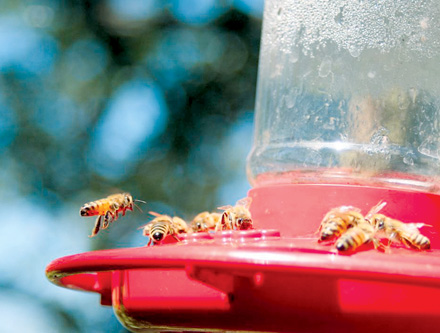Bees in Feeders

Between calls and emails, you would have thought bees were taking over the world, or at least mid-Missouri. I don’t blame the callers for being concerned, more and more honeybees are becoming prominent backyard visitors.
At this point in the season, honeybee colonies are at their highest population levels. Bees will fly between two to four miles from their home hive looking for food. With record hot temperatures over 90F for several days, plants shut down pollen production leaving bees scrounging for food. Although many colonies have a nice stash of saved honey by now, some will turn to eating their stores if they can’t find other food sources.
Usually this dearth hits Missouri in August. This year, it has been a good month early.
There is a bit of a respite when we have rain. Some rains give plants a boost and plants start producing pollen again. Several days of record hot temperatures once again shuts plants’ pollen production down. Because we have had an extended hot streak, bees are looking for food in all of the wrong places – hummingbird feeders in particular. They are reportedly visiting bird baths and swimming pools.
One of the recommendations I have read is to make sure your feeders don’t have anything yellow. The yellow color attracts bees and wasps. If you have hummingbird feeders with yellow flowers, gently pop them out for now. Hummingbirds can still get to the syrup with their long tongues.
Of all of the techniques people have suggested, the only one I know that works is feeding bees away from hummingbird feeders. To do, take a plant saucer, or use a bird bath; add rocks and twigs, then sugar syrup made of two parts water to one part sugar. This is twice the concentration of hummingbird syrup, which is four parts water to one part sugar.
Use hot water to dissolve the sugar; then allow to cool before feeding for both bees and hummingbirds.
Place the bee feeder away from the hummingbird feeders. You may need to initially place it close to the hummingbird feeders to get the bees attention but once you have buzzing visitors, move it away from bird feeders. Bees will share the new location with their sisters and stay away from the hummingbird feeders as long as you keep the thicker sugar syrup served.
Frankly this active bee stage doesn’t last long. Worker bees only live for six weeks over summer, dying after they wear their wings to shreds. Hot weather tends to shut down the queen laying so colony numbers will soon start to decline getting ready for winter.
Hummingbirds traditionally migrate back to central and South America by mid-September so by the beginning of fall, all we have left to contend with are yellow jackets. These wasp cousins of honeybees are the same size but are ground nesters and repeatedly sting when provoked. Honeybees only sting once and then die.
And sorry, even if the bees bothering your hummingbirds were from my hives, there is little I can do to encourage them to stay home.
Charlotte Ekker Wiggins is a certified gardener, beekeeper and occasional cook. Copyright 2016 used with permission, all rights reserved. This material may not be published, broadcast, rewritten or redistributed. Contact Charlotte at chargardens@gmail.com.
Charlotte Ekker Wiggins (hyperlink to www.charlotteekkerwiggins.com) is a certified gardener (hyperlink to www.gardeningcharlotte.com) and beekeeper (hyperlink to homesweetbees.com) Copyright 2016 used with permission, all rights reserved. This material may not be published, broadcast, rewritten or redistributed. Contact Charlotte at chargardens@gmail.com.

SWEET TEETH – Honeybees are attracted to hummingbird feeder syrup this time of year because they have few other sources of food.



Facebook Comments